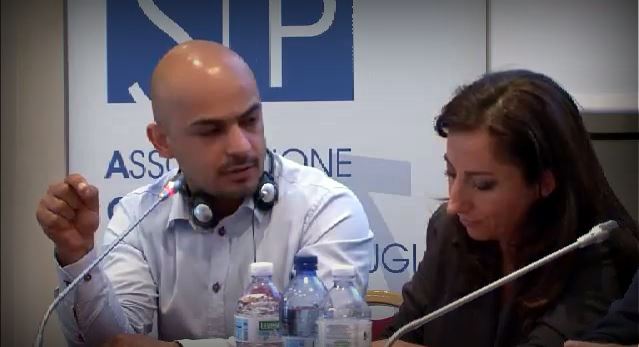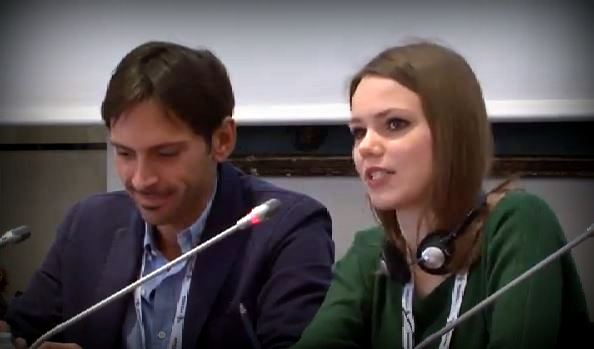The second day of the International Journalism Festival 2014 featured a discussion on one of the hottest topics in international politics today – the Ukrainian Crisis. Three renowned Ukrainian journalists – Mustafa Nayem, Anna Babinets and Olga Tokariuk, and the RaiNews24 foreign correspondent Lucia Goracci demystified some of the misconceptions of the contradictory media coverage of the Maidan.
By Krystina Shveda
(Edited by Gretchen Gatzke)

November 21, 2013 saw a sudden and unexpected retreat of the now-deposed Ukrainian President from signing the European partnership agreement. On that evening, Mustafa Nayem, a Ukrainian journalist and opinion leader, posted on Facebook, prompting the Ukrainian citizens to go to Kiev’s main square – Maidan – and demonstrate their disapproval. On the first day, the number of protesters grew from five people to 50 within an hour, and finally to hundreds of people of all ages, social classes and ethnicities.
“Nobody believed the Maidan would stay more than a week,” Nayem said. “But we stayed. Nobody believed it would still be here after the New Year. We stayed.”
While the confrontation sparked by the Russia’s military continues to grow in the Eastern part of Ukraine, European journalists – and so, citizens – are struggling to understand what really happened at Maidan, and which one of the opposing explanations conforms to reality. Instead of visiting Kiev to witness and form an objective opinion, many European media simply rehash the messages generated by the Russian media, while the voices of the Ukrainian journalists who risk their lives to show the events live to the world, are unheard. Only negative events are featured in the EU media; coverage of peaceful periods are lacking, which leads to the misunderstanding of the influences of local, historical and geopolitical factors.
Myth 1: Ukrainian people who support the new government are opposition/far right nationalists/fascists

According to Nayem, only a small portion of the protesters represent political opposition. There were creative professionals, university professors, businesspersons and rural area workers who traveled from all corners of the country; pensioners who remembered the sufferings of the Soviet times; and students brought up in the Orange revolution. There was even a brave 16-year old who lied to his mother, telling her that it was totally safe to be at Maidan.
Sympathizing Armenians, Chechens, Belarusians, Jews, Crimean Tatars and even Russians joined the movement. The first person to be killed was Armenian. Anti-semitic and racist actions were unthinkable, and the Ukrainian Jews supported the Maidan – take Mr. Khodorkovsky, a Russian businessman of Jewish origin, who was at Maidan, too.
Mustafa Nayem himself is of Afghan origin, and his colleague Anna Babinets’s family comes from the Russia’s Siberia.
The Ukrainian population has spoken both the Ukrainian and Russian languages for decades. Nayem confessed to using the Russian language in his family, and Ukrainian as a language for professional communication. The the biggest television channel in Ukraine is transmitted in Russian. At Maidan, all kinds of languages were spoken – Ukrainian, Russian, Armenian, Jewish, and many others.
Myth 2: The Ukrainian nationalists initiated the violence on Maidan
For two months, the protests were peaceful. When the Yanukovych’s government began to use forceful measures against free citizens, a more radical part of the Maidan emerged in response.
Still, according to a recent poll, only 2% of the population supports Dmytro Yarosh and his Pravy Sektor, the newly-formed right-wing party in Ukraine. Some of the party’s radical statements served as a hook for Russia’s media to play on human emotions and paint a negative portrait of the country. Nayem emphasized that the Ukrainian and Russian people have been living in peace for years, but the moral question lies in the ability of the European Union to accept that Russia may become its bordering country.
Myth 3: All residents of Eastern Ukraine and Crimea want to be a part of Russia
According to Olga Tokariuk, a Ukrainian freelance journalist, the support of Yanukovych’s deposition involved all of Ukraine. When the regime fell, many Ukrainians felt relieved, even in the East.
On March 16, the so-called “referendum” was organized by Russia in Crimea, with the result of 97% votes said to be in favor of the Crimea annexation. In Ukraine, the referendum is not acknowledged as legitimate, but the geopolitical situation allows little chance to dispute that openly. Today, the new government has been taking the first steps to rebuild the country, but Russia continues to destabilize the situation with military operations and provocations. The future of Ukraine depends strongly on the EU.

Lucia Goracci, who was in Crimea in the epicenter of the events, saw that after Yanukovych fled away and the Russian Parliament gave Putin the green light to intervene in Ukraine, the Russian and pro-Russian military with no distinguishing signs overtook the peninsula. The military bases were immediately occupied by people in masks. Ukrainian soldiers walked out unarmed and the Russian military shot into sky. That was the moment when the EU understood that the Crimean force was under Russian seizure. The Italian journalist was touched by Mykola Balabanau, the Ukrainian commander from the western part of the country, and the only member of the military to fight until the end.
Goracci did notice some interest among the civilians in joining Russia, but she says that people of the region are largely influenced by a systematic brainwashing by the Russian media (the Ukrainian media were banned at the time of referendum). Supposedly, the primary reason behind this interest consisted of the socioeconomic hopes of people, as the rubble is stronger than Ukrainian currency.
Nayem reminded the audience that a referendum was an instrument that also began World War II. He insisted that the referendum held by Russia in Ukraine was an illegal act, most likely planned long before the events in Crimea.
Myth 4: The Ukrainian independent media are sponsored by the Western conspirators
Hromadske.tv, one of the core independent media forces in the new Ukraine, was started by Mustafa Nayem, Anna Babinets and their colleagues a year before the Ukrainian crisis. Then, the majority of media were ruled by the government or oligarchs involved in politics. Private funding of the broadcast media inevitably led to propaganda and false information broadcasted on television. Nayem said he simply couldn’t work for the biased, government-run television, and subsequently quited his job. Joined by 17 colleagues with the same vision and an established reputation among the Ukrainian readership, he co-founded a new online station called Hromadske.tv. The project was warmly greeted by the public, and more than 30,000 euros were raised. People supported the online station because its correspondents reported live from the most active spots, day and night. “Many events happened at night when the traditional journalists were sleeping,” Nayem said. “But not us.”
According to Nayem, the new government is afraid of Hromadske.tv because it is critical of the new politics. Although he agrees that the new government does need support, he is convinced that free media exist in order to ensure that the government leverages its new power in the most effective way.
Myth 5: The investigations of the inadmissible wealth of Yanukovych are part of the opposition’s propaganda

One of the reasons the protests started lies in a strong disparity between the growing wealth of the President and the poverty of millions of Ukrainian citizens. Anna Babinets, Hromadske.tv co-founder has always seemed to be in the right place at the right time. She explained that before Yanukovych escaped his large and luxurious residence named Mezhihirya (144 hectares of land almost equal to the size of Monaco), someone tried to destroy various documents in the lake. In a joint effort, a group of journalists, including Babinets, quickly found and saved more than 23,000 wet documents, created a website Yanukovichleaks and gathered a community to process the documents.
The papers included information on the price of Yanukovych’s residence, people connected to him, and other crucial information. The data was presented to the prosecutors for further action.
Nayem added that Mezhihirya was previously a governmental residence, but Yanukovych stole it from Ukrainian people. Many investigations made by Nayem and his colleagues over the previous years suggested that the President lived in luxury despite the growing economic crisis in the country. Now that the data was verified, the readers who had trusted them for three years knew they had done the right thing.
* * *
“The efforts of the international society can help Ukraine survive,” Nayem said. “It is impossible to resist the undeclared war alone. Not more than two hours would Ukraine stand before Putin is in Kyiv. In this conflict, you, EU journalists, can choose between the two point of view. I cannot.”
The next day to look at is May 25 – the presidential elections in Ukraine. Russia will try to boycott them. The next day, there are European elections. So, think who you vote for. The future of Europe and Ukraine is now intertwined.”